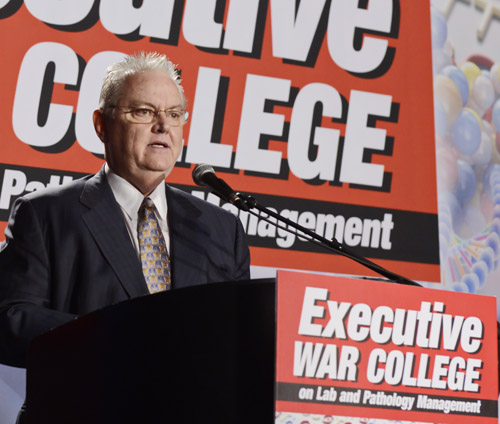Medical laboratories and anatomic pathology groups are scrambling to respond as healthcare evolves into new models of integrated clinical care and payers seek to reduce reimbursement for clinical lab tests
NEW ORLEANS, LA.—There was more bad news than good news for the 800 clinical laboratory professionals and pathologists who assembled this week in “The Big Easy” to discuss and debate the serious financial and clinical challenges now weighing down the entire profession of laboratory medicine in the United States.
Probably the most unwelcome news delivered to attendees at the 19th Annual Executive War College on Laboratory and Pathology Management, was the contents of the new law titled the “Protecting Access to Medicare Act of 2014” (PAMA). This was the legislation passed by Congress to patch the Sustainable Growth Rate (SGR) formula for one more year. It was signed into law by President Obama on April 1, 2014.
New Federal Law Will Change Several Things for Clinical Lab Industry
Many lab administrators and pathologists in the audience were surprised to learn that the new law affects their lab organizations directly in two important ways:
• First, beginning on January 1, 2016, the law mandates that most medical laboratories must report to the Centers for Medicare and Medicaid Services (CMS) the volume of each clinical laboratory test and price paid for each lab test by private payers.
• Second, beginning on January 1, 2017, CMS is to use this market data to establish prices for the Part B Clinical Laboratory Fee Schedule (CLFS). The new law constrains Medicare officials from dropping the price for any single clinical laboratory test by no more than 10% each year during 2017, 2018, and 2019 and no more than 15% each year during 2020, 2021, and 2022.
This means price cuts on specific clinical laboratory tests during these years could total as much as 75% by 2022. Informed observers believe Medicare officials will apply these cuts to the 20 lab tests that represent 56% of the CLFS payments Medicare made to labs during 2010. This was explained in the April 28, 2014 issue of The Dark Report. An upcoming Dark Daily will cover this development in more detail.
Good News for Medical Labs Responding to Integrated Clinical Care
As to the good news, several speakers spoke positively about the progress their clinical laboratory organizations are making as they respond to healthcare’s shift toward integrated clinical care and value-based reimbursement. Some examples are:
• At NorDx Labs in Scarborough, Maine, President Stan Schofield introduced the Executive War College attendees to his “Five Rules for Successful Laboratories” and the “Four Questions That Every Lab Leader Needs to Know.” Essentially, his recommendations centered on dynamic execution of lab operations, informed by real-time metrics. He urged the audience to proactively develop value-based medical laboratory testing services and assertively educate physicians and payers about how to use these services to achieve their own respective goals.
• At DynaLifeDx Labs in Edmonton, Alberta, CEO Jason Pincock guides a lab organization that provides services under a fixed-reimbursement agreement with the Alberta Health Service. His lab’s performance metrics are posted daily on the lab’s website and can be viewed by the public. Pincock identified the leadership strategies used to align the lab team with these goals and explained how DynaLife uses relationship management tools and value-added services to fulfill its mission.
• At the University of Miami Health System in Miami, Florida, Richard J. Cote, M.D., FCRPath, FCAP, is the Chair of the Department of Pathology. He spoke to the challenges of serving integrated clinical care organizations. Cote recommended that lab leaders find worthwhile targets that would allow their labs to improve utilization of tests. These can include programs to address high-volume tests, high-priced tests, and the tests ordered by clinicians with the highest variability.

NorDx Labs of Scarborough, Maine, is pushing forward with new value-added clinical laboratory testing services to meet the changing needs of ACOs, medical homes, and other forms of integrated healthcare organizations. At the 19th Annual Executive War College this week in New Orleans, Stan Schofield, CEO of NorDx, shared his “Five Rules for Successful Laboratories.” (Photo by Duane Stork)
In fact, the theme of more dynamic management of lab operations and work flow—informed by real-time management dashboards—was common to many of the presentations delivered by speakers at this year’s Executive War College. This is one effective response to the falling reimbursement and shrinking budgets hitting labs throughout the United States.
Essential Insights from Executive War College 2014
A full report of essential insights developed from the 60 sessions and 90 speakers at this year’s conference will be presented in the May 19th issue of The Dark Report. Despite the financial headwinds facing the clinical laboratory, most speakers here at the Executive War College were optimistic that their lab organizations could maintain quality lab testing services, even as integration of clinical care goes forward.
Yours truly,
Robert L. Michel
Your Dark Daily editor
Related Information:
Live Digital Audio Recording Set Now Available! Executive War College 2014



